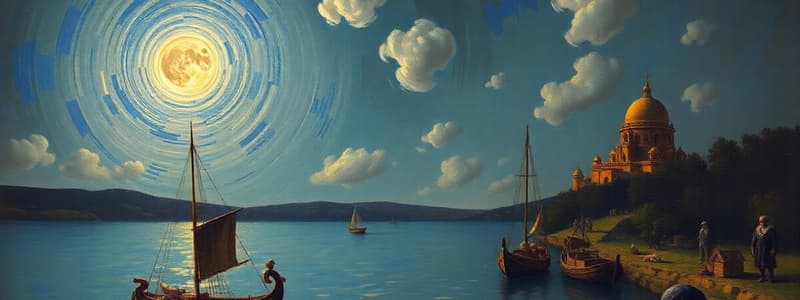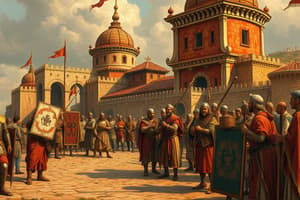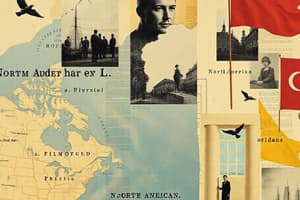Podcast
Questions and Answers
Which of the following statements accurately describes the Portuguese strategy in the Indian Ocean during the 15th and 16th centuries?
Which of the following statements accurately describes the Portuguese strategy in the Indian Ocean during the 15th and 16th centuries?
- They established large colonies with extensive land holdings.
- They focused on conquering and controlling entire regions, like Spain did in the Americas.
- They relied primarily on diplomacy and trade alliances rather than military force.
- They established fortified trading posts to control key trade routes and resources. (correct)
What was the primary reason for ongoing rivalry between the Ottoman Empire and the Habsburg Dynasty?
What was the primary reason for ongoing rivalry between the Ottoman Empire and the Habsburg Dynasty?
- Religious and territorial conflicts, with the Ottomans being Muslim and the Habsburgs being Catholic. (correct)
- Competition for control over trade routes in the Indian Ocean.
- Disagreements over the boundaries of their respective colonial empires.
- Economic rivalry, stemming from their control over different resource-rich regions.
Which of the following was a key factor in the decline of the importance of castles and armored knights in warfare during the 15th and 16th centuries?
Which of the following was a key factor in the decline of the importance of castles and armored knights in warfare during the 15th and 16th centuries?
- The decline of feudalism and the rise of centralized monarchies.
- The introduction of cannons and firearms, which could penetrate castle walls and armor. (correct)
- The increasing use of mercenaries and professional armies over traditional feudal levies.
- The development of new naval technologies, such as the caravel and the galleon.
Which of the following best describes how the Spanish monarchs used architecture to demonstrate their power?
Which of the following best describes how the Spanish monarchs used architecture to demonstrate their power?
How did the use of gunpowder weapons contribute to the centralization of states in Europe during the 15th and 16th centuries?
How did the use of gunpowder weapons contribute to the centralization of states in Europe during the 15th and 16th centuries?
Which of the following was NOT a key factor in the shift from European trade to colonialism?
Which of the following was NOT a key factor in the shift from European trade to colonialism?
Which of the following was an important consequence of Christopher Columbus’s voyages to the Americas in 1492?
Which of the following was an important consequence of Christopher Columbus’s voyages to the Americas in 1492?
What is the encomienda system, as practiced by Spain in the Americas?
What is the encomienda system, as practiced by Spain in the Americas?
What was the primary purpose of the Spanish Inquisition?
What was the primary purpose of the Spanish Inquisition?
How did the Ottoman Sultans use Islam to justify their rule?
How did the Ottoman Sultans use Islam to justify their rule?
In what way did the Ottoman Empire’s conquest of Constantinople in 1453 have a significant impact on European history?
In what way did the Ottoman Empire’s conquest of Constantinople in 1453 have a significant impact on European history?
What was the main impact of the Scientific Revolution on politics?
What was the main impact of the Scientific Revolution on politics?
What was the main purpose of the Battle of Lepanto (1571)?
What was the main purpose of the Battle of Lepanto (1571)?
What did Martin Luther's criticisms of the Catholic Church lead to?
What did Martin Luther's criticisms of the Catholic Church lead to?
How did the Protestant Reformation impact the relationship between European rulers and the Pope?
How did the Protestant Reformation impact the relationship between European rulers and the Pope?
Which of these is NOT a characteristic of Louis XIV's rule in France?
Which of these is NOT a characteristic of Louis XIV's rule in France?
What was the main reason European powers shifted their focus from trade to colonialism?
What was the main reason European powers shifted their focus from trade to colonialism?
How did the Transatlantic Slave Trade impact the relationship between Africa and Europe?
How did the Transatlantic Slave Trade impact the relationship between Africa and Europe?
Flashcards
Portuguese Expansion in Indian Ocean
Portuguese Expansion in Indian Ocean
Portugal was the first European country to explore the Indian Ocean, establishing trading posts and controlling key routes.
Spanish Colonization of the Americas
Spanish Colonization of the Americas
Spain colonized large territories in the Americas, using the encomienda system to exploit indigenous labor.
The Habsburg Dynasty
The Habsburg Dynasty
The Habsburgs were a powerful family in Central Europe who expanded their influence through marriage and controlled the Holy Roman Empire.
Battle of Lepanto
Battle of Lepanto
Signup and view all the flashcards
Impact of Cannons
Impact of Cannons
Signup and view all the flashcards
Ottoman Conquest of Constantinople
Ottoman Conquest of Constantinople
Signup and view all the flashcards
Encomienda System
Encomienda System
Signup and view all the flashcards
Gunpowder Age
Gunpowder Age
Signup and view all the flashcards
Spanish Monarchs' Architecture
Spanish Monarchs' Architecture
Signup and view all the flashcards
Süleymaniye Mosque
Süleymaniye Mosque
Signup and view all the flashcards
Scientific Revolution
Scientific Revolution
Signup and view all the flashcards
Heliocentrism
Heliocentrism
Signup and view all the flashcards
Protestant Reformation
Protestant Reformation
Signup and view all the flashcards
Absolutism in France
Absolutism in France
Signup and view all the flashcards
Colonialism Transition
Colonialism Transition
Signup and view all the flashcards
Trans-Atlantic Slave Trade
Trans-Atlantic Slave Trade
Signup and view all the flashcards
Plantation Economy
Plantation Economy
Signup and view all the flashcards
Study Notes
Portuguese and Spanish Expansion
- Portugal pioneered exploration of the Indian Ocean, establishing trading posts along African coasts, and reaching India by 1498 (Vasco da Gama).
- Portuguese used superior technology (ships and cannons) to control key trade routes and cities in the Indian Ocean.
- Portugal's goal was controlling trade (spice trade), not large-scale colonization.
- After Columbus's voyages, Spain and Portugal colonized the Americas.
- Spain focused on conquering large empires (Aztecs, Incas) using the encomienda system.
- Portugal focused on Brazil, using plantation slavery for sugar production.
Ottoman Empire and Habsburgs
- Ottoman Empire, founded by Osman Gazi in the 1300s, rapidly expanded, conquering Constantinople (1453).
- Habsburgs controlled much of Central Europe and Spain, gaining power through marriages. Included the Holy Roman Empire.
- Religious rivalry existed between Muslims (Ottomans) and Catholics (Habsburgs), leading to conflicts like the Battle of Lepanto.
- Habsburg-Ottoman conflict involved territorial expansion and religious differences
Impact of Gunpowder Weapons on State Centralization
- Before gunpowder, warfare relied on knights and castles.
- Cannons and firearms made castles less effective, and armored knights less useful.
- Centralized states benefited from gunpowder technology, as they could afford larger standing armies to crush local rebellions.
- Examples include the Ottoman conquest of Constantinople and strengthening of European monarchies.
Architectural and Religious Displays of Power
- Spanish monarchs built magnificent palaces (like El Escorial) to showcase wealth and power.
- Ottoman rulers constructed grand mosques (like the Süleymaniye Mosque) to demonstrate religious authority and strength.
- Both empires employed public spectacles (ceremonies, parades) to project power and control.
- Religious authority was demonstrated through punishment of heretics (Spain) and Islamic rule justification (Ottomans).
The Scientific Revolution
- The Scientific Revolution (1500s-1600s) challenged traditional knowledge emphasized experimentation and observation.
- Heliocentrism (Earth orbits the Sun) was promoted by Copernicus and Galileo, challenging the Church.
- Newton's laws revolutionized understanding of the universe's physical principles.
Protestant Reformation and State Power
- Martin Luther's criticisms (1517) of the Catholic Church (indulgences, corruption) started the Reformation.
- Some rulers supported Protestantism to reduce the Pope's authority and increase their own power.
- Examples include German princes resisting Habsburg control and King Henry VIII establishing the Anglican Church in England.
Absolutism in Europe
- French King Louis XIV (Sun King) solidified his absolute rule, controlling nobles and asserting "I am the state."
- Russian Tsars like Peter the Great copied French centralization.
- While absolute, Russian rulers had to negotiate with nobles (boyars) but still held ultimate power.
Transition from Trade to Colonialism
- European trade initially involved establishing posts in Africa, India, and the Americas.
- Desire for wealth and increased military power through gunpowder technology spurred the shift to conquest.
- Competition between European powers (Spain, Portugal, France, England) fueled colonial expansion and control.
American Colonial Institutions
- Spain and Portugal's American colonies developed institutions for control:
- Encomienda system for using native labor,
- Viceroys represented the monarch,
- African slave labor replaced indigenous labor.
African States and the Trans-Atlantic Slave Trade
- Coastal African states participated in trading enslaved people for European goods, like guns and textiles.
- Some African rulers benefited economically and politically by controlling the slave trade.
The Trans-Atlantic Slave Trade and Plantation Economy
- The North Atlantic System linked Europe, Africa, and the Americas in a triangular trade system.
- The slave trade's brutal "Middle Passage" transported enslaved people to the Americas.
- Enslaved labor powered the plantation economy producing cash crops (sugar, tobacco, cotton) for European markets.
- Demand for cash crops and labor shortages fueled the slave trade.
Studying That Suits You
Use AI to generate personalized quizzes and flashcards to suit your learning preferences.




